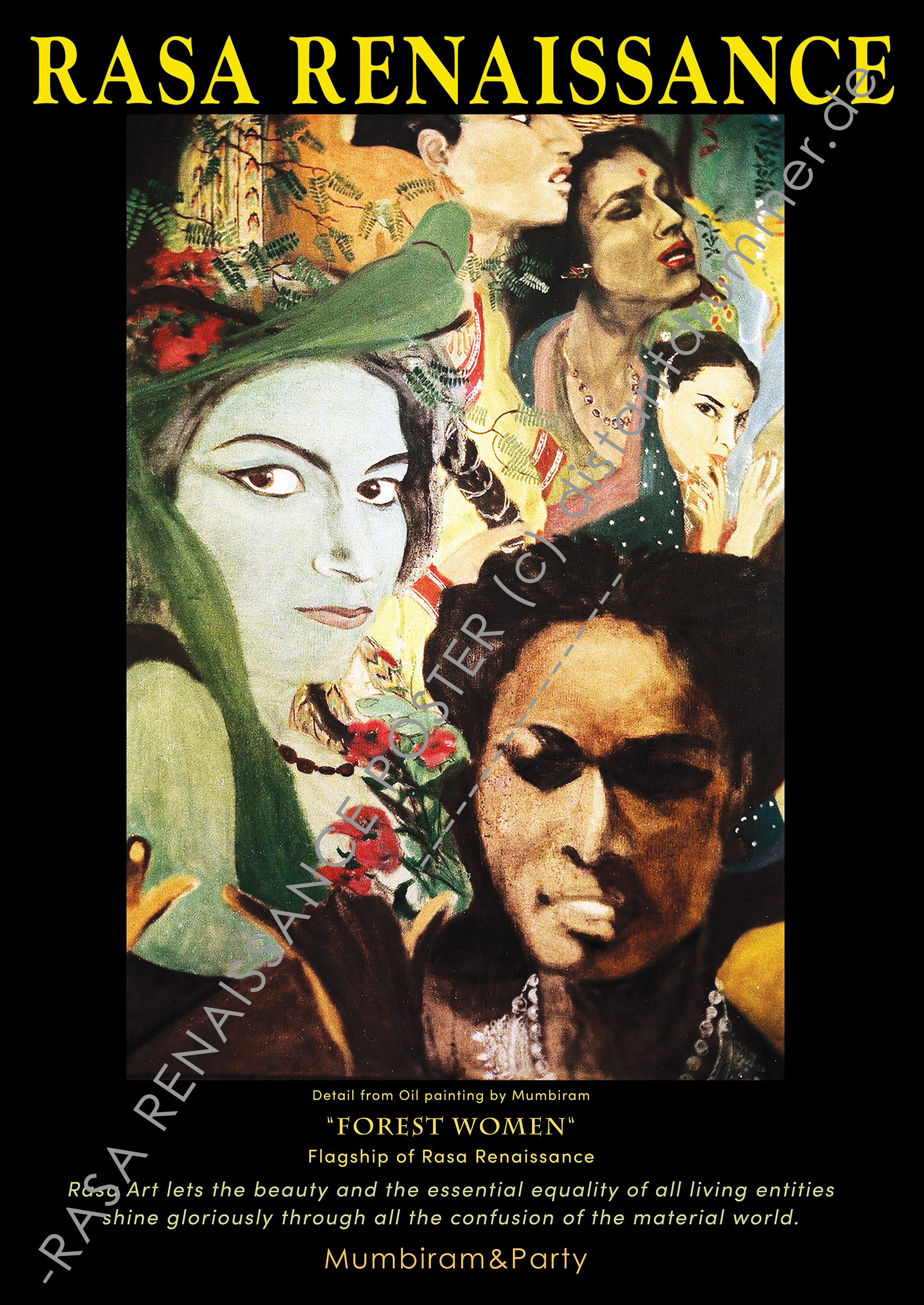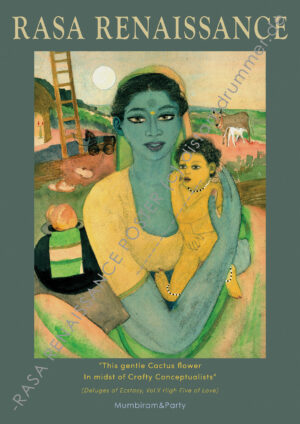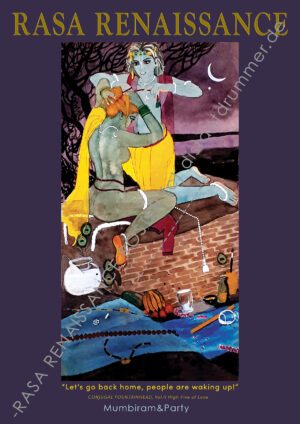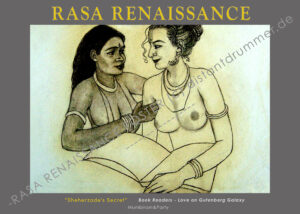“Forest Women” Poster
108,00 € – 208,00 €
incl. VAT plus Shipping Costs
Rasa Renaissance Poster based on detail from original oil painting “Forest Women” by Artist Mumbiram
Collector’s item individually signed by Artist Mumbiram
Description
Rasa Renaissance Poster based on detail from Artist Mumbiram’s original painting “Forest Women” – the Flagship of Rasa Renaissance
Caption on the Poster:
Detail from Oil painting by Mumbiram
“Forest Women“
Flagship of Rasa Renaissance
Rasa Art lets the beauty and the essential equality of all living entities
shine gloriously through all the confusion of the material world.
Mumbiram&Party
High Quality Print (semi gloss paper, 195g/m2)
Available in 3 Sizes:
A2 (42x59cm)
A1 (59x84cm)
A0 (84x118cm)
This is a collector’s item. You will get your Rasa Poster individually signed by Artist Mumbiram.
Rasa Appreciation of original oil painting
“Forest Women” – the Flagship of Rasa Renaissance
(Oil painting, 1985, Mumbiram)
Krishna’s love affairs with the young ‘gopis’, the damsels of the cowherd families, are well known through the classical scriptures of India. Very little is known about how women of other castes and communities in that society viewed Krishna. When Mumbiram read the 10th canto of the Shrimad Bhagavatam that describes Krishna’s life, he was fascinated by a verse that described how passionately the wild forest women, living in the wilderness around Govardhan mountain, were attracted by the vision of Krishna sitting with the gopis on the bank of the Yamuna. This inspired Mumbiram to make one of his very first Krishna paintings. That was in Seattle in 1976. It was a mural painted on the wall of an Indian restaurant on University Avenue. The second version was made soon after on a small canvas that Mumbiram carried with him on his journey from Seattle to Washington D.C. in January 1977. He left it with a member of the choir of the Seventh Day Adventist church in Denver Colorado that had an enthusiastic Afro-American congregation. They had sheltered Mumbiram and facilitated his journey to D.C.
A few other versions that Mumbiram made are likely to have survived. This detail is from the latest and last version he made in 1985 in his legendary Mandai atelier in his native Pune in India. It was made for the leading Orthopedic Surgeon of India Dr. H.K.Sancheti. Thereafter it changed hands several times in amazing circumstances yet came back to his atelier every time. There it graced that legendary atelier in a dilapidated house at the Mandai vegetable market. It was legendary because it was witness to a miraculous chapter in the history of art. That unlikely place was attracting men and women of diverse exotic ethnicities of India on the one hand. These were often the poorest and the most neglected sections of Indian society. The artist who was attracting them thrived on their unconventional extraordinary beauty that was ever neglected by mainstream art and culture. On the other hand Mumbiram was attracting art lovers from across the world who were visiting Pune and who came to know about this extraordinary artist of most attractive life style and equally attractive art. That atelier became the cradle of Rasa Renaissance, the movement that created a soulful and emotional alternative in the domain of contemporary art that had become entirely abstract impotent and irrelevant.
This image is a detail from this last and most well known version on the theme of the Forest Women visiting Krishna and the Gopis. Like many other masterpieces that Mumbiram made, even details from his paintings are attractive. This detail will certainly make you curious about the entire original painting. There Krishna is sitting surrounded by his favorite Gopis while the forest women who are aroused by that vision are hovering around. Mumbiram’s creative genius avoids the obvious and ads an element of most pleasant surprise. In Mumbiram’s vision the gopis are well-known Bollywood actresses of contemporary Indian cinema. The forest women here are not at all the so-called tribal women of India. In Mumbiram’s vision they are international divas whose beauty does not conform to the Indian stereotypes of beauty.
A lot has been written about this painting and a lot will still be written. Distant Drummer is bringing out a book exclusively about the saga and adventure this painting has gone through. Three ways in which this painting makes important contribution can be summarized as follows:
1. It is an innovation in composition. The space is created solely through juxtaposition of faces and their gazes. It is Personalism taken to its amazing heights.The natural ease in rendering, the great variety of ecstatic moods and variety of human types shows Mumbiram’s acutely evolved sense of portraiture.
2. Mumbiram’s vision and rendering make a statement in the domain of Aesthetic Justice and Equality: That God-consciousness must not be the monopoly of any caste or creed or nationality.
3.The third and most fascinating aspect is that through graceful choices of contemporary faces, manners and styles Mumbiram is bringing esoteric scriptural visions into today’s daylight. Mumbiram is introducing the Prema Vivarta mood. Spiritual pursuit need not entail any neglect or denial of the material world around us. To a person in the Prema Vivarta mood everything in the material world reminds something in the spiritual world.
Above all and in short, through his art Mumbiram is celebrating a Universal Paradigm of Love and Beauty. It lets the joy, beauty and essential equality of all living entities shine gloriously through all the confusion of the material world.
This painting is rightly considered by many as the Flagship of the Rasa Renaissance movement. The painting was acquired in 1996 by an executive of Mercedes Benz of India and carried to Stuttgart in Germany.
Related products
-
- Rasa Renaissance Poster
“Hirkani” Poster
- 108,00 € – 208,00 €
- Select options This product has multiple variants. The options may be chosen on the product page
-
- Rasa Renaissance Poster
“Let’s Go Back Home” Poster
- 108,00 € – 208,00 €
- Select options This product has multiple variants. The options may be chosen on the product page
-
- Rasa Renaissance Poster
“Sheherzade’s Secret” Poster
- 108,00 € – 208,00 €
- Select options This product has multiple variants. The options may be chosen on the product page




